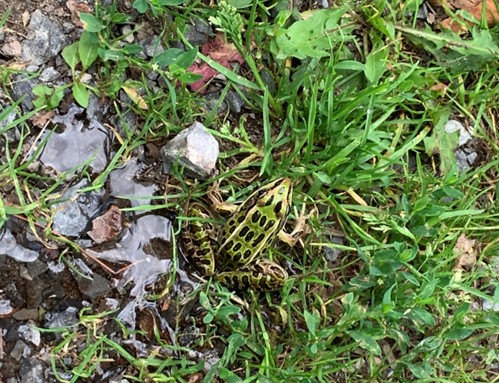by Fred Schueler & Aleta Karstad,
Fragile Inheritance Natural History
On the 23rd of July, the first juvenile Leopard Frog of 2023 arrived at Bishops Mills. Leopard Frogs have traditionally hibernated in the branch of the creek (Middle Creek) below Bishops, and have crossed County Road 18 in April to breed in the ‘South Branch’ creek, with the resulting juveniles arriving in the hamlet on an average date of August 1. The arrival dates range from July 18 to August 17 and are later in drier years.
The arrival date seems to be unrelated to abundance, but this early return may indicate a recovery from very severe declines after the hard winter of 2013-2014. Claudia Lacroix at the University of Toronto analysed our data about animals on the streets: “From 2003 to 2019, we performed thousands of rapid (5 – 15 min) amphibian surveys and recorded the number of on-road amphibians along a single 267 m stretch of [streets in Bishops Mills]…. we show a remarkable 91% decrease in the abundance of Northern Leopard Frogs (Lithobates pipiens), the species comprising the most observation records, while all other species did not show a temporal trend.” (Animal Conservation – April 2023, by Claudia Lacroix, Frederick W. Schueler & Njal Rollinson: A 91% decline in a common anuran in an otherwise stable amphibian community inferred from 17 years of rapid road surveys.)
We’re not sure what caused the decline which was more severe in Bishops Mills than it was elsewhere in the Kemptville Creek drainage basin. Hard winters with no oxygen in the aquatic hibernation sites, and the loss of pasture/hayfield habitats to intensified cultivation and brushy second growth may have been factors. Last year there seemed to be some recovery, and this year’s juveniles suggest that this recovery is increasing.
The decline was also apparent in our springtime counts of “damsel frogs” (dispersing non-breeding yearling females) around our vernal pond. Eleven, juveniles of 2022, were there on 6 May, and this was the highest count since 2010, though nothing like the 106 that were at the pond on 9 May 2005.
Because they summer on land, and hibernate in one kind of waterbody while breeding in another kind, moving across country for kilometres to get to these habitats, making themselves vulnerable to roadkill, Leopard Frogs are emblems of landscape connection and integrity, and we can only hope that they’ll continue to increase toward their historic abundance.







the published paper is Lacroix, Claudia, Frederick W. Schueler, Njal Rollinson. 2023. A 91% decline in a common anuran in an otherwise stable amphibian community inferred from 17 years of rapid road surveys. Animal Conservation – April 2023 – https://www.researchgate.net/publication/370207201_A_91_decline_in_a_common_anuran_in_an_otherwise_stable_amphibian_community_inferred_from_17_years_of_rapid_road_surveys
…and here’s the analysis of arrival dates – http://www.doingnaturalhistory.com/2020/04/arrival-of-juvenile-leopard-frogs.html